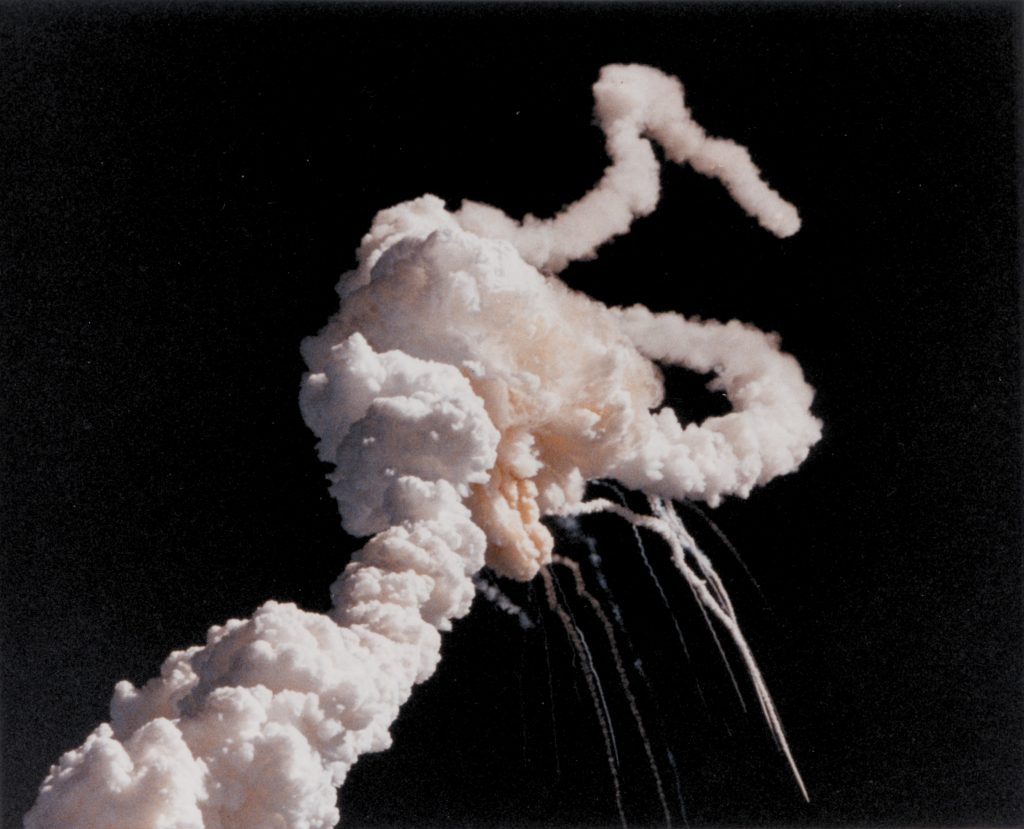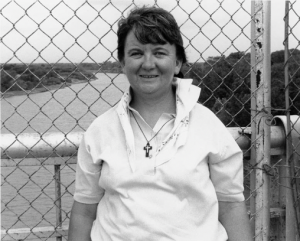On the evening of January 27th, 1986, an engineer at a little-known company told his wife, “It’s going to blow up.” That man was Bob Ebeling, an engineer for Morton Thiokol, which had been contracted to manufacture and maintain the solid rocket booster (SRB) used by NASA’s space shuttle program. On that night, he and his coworkers tirelessly pleaded with NASA officials to delay the launch of the space shuttle Challenger until temperatures were more favorable. Sadly, NASA officials did not heed these warnings, and all seven crew members of STS 51-L lost their lives.1
This story starts before that tragic day with the creation of the space shuttle program. As you can imagine, any vehicle designed for space undergoes rigorous testing and analysis before being put into use. During these early tests, engineers at the Marshall Space Flight Center saw a potentially catastrophic flaw in the two o-ring design that the SRB used in its joints and reported their concerns to NASA in 1971. NASA disregarded these concerns and did not pass this report onto Morton Thiokol for further evaluation. NASA approved the shuttle program and put the shuttles into production. By the second shuttle mission, there was serious evidence that supported the original concerns for the SRB o-ring failure. The evidence continued to stack up with each subsequent mission. In 1985 Morton Thiokol decided to redesign the joint to include an additional three inches of steel, which would grip the inner face of the joint and prevent it from rotating and potentially failing. Both NASA and Morton Thiokol agreed to continue with the launch schedule while they worked on this fix and accepted the potential for failure as an acceptable flight risk.2
Despite this risk, no shuttle had ever suffered a catastrophic failure during launch, orbit, re-entry, and no crew member had ever been injured or killed during a mission. The Challenger had already completed nine successful missions at this point and future missions were continuously being planned. This perfect record was a point of pride for NASA, and confidence continued to grow. This confidence caused NASA to be overly optimistic in their promise of how cost effective and efficient the shuttle program could be. These promises resulted in immense pressure from the government and tax payers to deliver on their promises with an overly ambitious launch schedule.3
The launch of STS 51-L had been planned as the first launch of 1986, and it would also put the first teacher in space. The addition of Christa McAuliffe, an elementary school teacher from New Hampshire, to the mission had garnered national and international attention. The launch was scheduled for January 22, 1986, but due to the delay of other missions, the launch of 51-L was pushed back several times — first to January 23rd, then to the 24th, 25th, 26th, and finally the 27th. On the morning of the 27th during regular countdown procedures, a micro switch indicated a failure of an exterior hatch-locking mechanism. By the time this issue was fixed, the winds had exceeded launch criteria. The launch was delayed yet again.4

Managers at Morton Thiokol had been watching the delays from their headquarters in Utah and were tracking the conditions with each delay. On the evening of the 27th, they saw the temperature would be below freezing at the launch site the next morning, which presented potential problems, raising concern. The shuttle and SRB had never been certified to operate in temperatures that low. Bob Ebeling had written an official memo for NASA titled “Help!” in 1985 where he described the extremely high potential for both o-rings to fail in temperatures below 40°F, but NASA had ignored it. That evening a manager at Morton Thiokol called Ebeling to ask if the shuttle could launch the following morning in the freezing temperatures. When Ebeling informed them of the extreme risk, they immediately started crunching the numbers and building their argument for the delay of the launch. Morton Thiokol and NASA held a teleconference. NASA opposed all arguments for a delay, and stated that if one o-ring failed there was a secondary mechanism that would stop a catastrophic failure from happening. Morton Thiokol engineers continued to explain that was an incorrect assumption that would surely lead to disaster. Sadly, NASA officials disagreed, and a second teleconference was scheduled. Except this time, the Morton Thiokol engineers were excluded, only management from NASA and Morton Thiokol were included. In this second call Morton Thiokol management disregarded the warnings of their own engineers and recommended that the launch proceed as scheduled.5

At 11:38AM on January 28th, 1986, STS 51-L launched from Cape Canaveral, Florida. On board were seven crew members: Francis Scobee, Michael Smith, Ronald McNair, Ellison Onizuka, Judith Resnik, Gregory Jarvis and Christa McAuliffe. At 11:39:13AM, just 73 seconds after launch, the space shuttle Challenger broke apart at an altitude of 14,000 meters. All crew members were killed when their cabin plummeted into the Atlantic Ocean three minutes after the break up.6
This disaster led to the immediate grounding of all shuttle missions. President Reagan convened a commission, called the Rogers Commission, to investigate the Challenger disaster. The results of the investigation showed the mechanical cause of the break up was a failure in both o-ring seals, which led to catastrophic structural failure. The report more importantly considered the contributing causes of the accident. It concluded that both NASA and Morton Thiokol failed to respond adequately to the potential danger of the SRB design, and instead of taking immediate action they accepted it as a flight risk. It also uncovered the large disconnect between management and engineers, which led to people who didn’t truly understand the science and math making a decision that was based on pride instead of fact.7

These tragic events unfolded more than three decades ago but are relevant today more than ever. The first private civilian space mission is rapidly approaching, and as it draws closer, we have to look closely at our past mistakes. If we don’t we are destined to repeat them. The millions who watched these events unfold have not forgotten how horrified they were, and they also remember how much the nation was shaken from this tragedy. Ebeling sums these feelings up best when describing how he feels looking back at what happened, “I could have done more. I should have done more.”8 We need to do our best to get everything right the first time, especially when failure equates to lives lost. We need to continue to focus on this as space travel becomes more prevalent in our society, and like Morton Thiokol and NASA in the ’80s, we can’t value our pride more than human lives.
- Howard Berkes, “30 Years After Explosion, Challenger Engineer Still Blames Himself,” NPR, January 28, 2016, https://www.npr.org. ↵
- Wikipedia, 2018, s.v. “Space Shuttle Challenger Disaster,” https://en.wikipedia.org/wiki/Space_Shuttle_Challenger_disaster. ↵
- Howard Berkes, “30 Years After Explosion, Challenger Engineer Still Blames Himself,” NPR, January 28, 2016, https://www.npr.org. ↵
- Diane Vaughn, The Challenger Launch Decision: Risky Technology, Culture and Deviance at NASA, Enlarged Edition (Chicago, IL: University of Chicago Press, 2016), 1-3. ↵
- Wikipedia, 2018, s.v. “Space Shuttle Challenger Disaster,” https://en.wikipedia.org/wiki/Space_Shuttle_Challenger_disaster. ↵
- Funk & Wagnalls New World Encyclopedia, 2017, s.v. “Challenger Disaster.” ↵
- Wikipedia, 2018, s.v. “Space Shuttle Challenger Disaster,” https://en.wikipedia.org/wiki/Space_Shuttle_Challenger_disaster. ↵
- Howard Berkes, “30 Years After Explosion, Challenger Engineer Still Blames Himself,” NPR, January 28, 2016, https://www.npr.org. ↵



96 comments
Maggie Amador
As a fan of NASA, it is unfortunate that they let their pride get the best of them. Human lives should always be put first especially in the field of science where a lot of the technology being used is relatively new and dangerous. Congratulations on this being nominated for the best use of images! The images used truly add to the article as it was a broadcasted failure.
Dylan Coons
This is one of the most important events in modern American history. Despite it being a huge tragedy, it helped us learn the dos and don’ts of space travel. I had no idea how many warning signs NASA had before the launch. It’s sad that something so horrible had to happen because NASA did not want to delay a little bit longer to make sure everything was safe.
Robert Freise
The diaster of the challenger is oan American space shuttle expodes killing those in real time. It was really a sad event for the nation of the United States. Congratulation to the use of imagery in this article. It really magnitudes the overall meaning of how bad the accident of the challenger was. This article gave me a better sense of what happened before and after the challengers departure. This was a great article and a great read all together.
Julissa Cantu
The disgraceful actions of NASA are something that should be written about considering the figurehead the entity is and how much admiration the country holds for them. Boyd did well in describing the events and using pictures in order to explain the impact these actions held all those years ago. Boyd’s introduction and conclusion were also very impactful.
Luke Lopez
This was a very interesting article on the Space Shuttle Challenger’s disaster that resulted in the deaths of seven crew members on board. I did not know that there was a flaw in the Challenger that was not ready for travelling in space just yet. It is sad that the deaths of the seven crew members could have been avoided. Overall, this was a very well-written article on the Space Shuttle Challenger’s disaster.
Crystal Baeza
I enjoyed how the article had me engaged from the very beginning. It’s heartbreaking reading how seven lives could have been saved if NASA would have listened instead of only thinking for themselves. For crying out loud, you would think a mission like that would have had better precautions and made sure everything was perfect before take off. The image with build up ice should have been a big red light. It’s truly a tragedy but mistakes are always lessons learned and I hope this was major one for NASA. I though this was a great article and think you deserved the nomination for Best Use of Images. Congrats!
Jose Fernandez
Congratulations on the nomination! The images for your article are great. I really enjoyed reading it and the title really caught my attention. I think it is very well written and I can tell a lot of research was made before its creation. It is sad that even though NASA received so many warnings about possible malfunction, they still launched the mission. It was completely irresponsible. The warnings were there, and they still chose to send 7 people to the sky. It is horrible how this all ended. And it is sad that such catastrophe had to occur in order for NASA to fix their errors. I can only think about the families of the victims.
Richard Morales
Great article over an important event in American history. This tragedy was quite unfortunate and after reading this article I am convinced it could have been avoided. NASA should have delayed the launch due to the compromising circumstances. There should have been more precautions and NASA should not have conducted the launch on a day with such poor, freezing conditions. Overall great read, congratulations on your nomination.
Pamela Callahan
I think danger is always a constant threat when it comes to space travel, but what I found to be exceedingly sad about this case is that the whole situation could have been avoided. If only the NASA officials had listened to the numerous warnings they had received, then maybe the lives that were lost could have been saved. Congrats on the nomination!
Greyson Addicott
This article made an amazing case for the idea that the Challenger was destroyed as a result of willful ignorance, rather than accident. Personally, I can certainly believe that NASA knew the risks before giving the go-ahead with the launch. The fact that the launch was scheduled to occur on the very morning that temperatures would go below 40 degrees Fahrenheit is a great tragedy. Regardless, I suppose NASA found out the hard way that Bob Ebeling knew what he was talking about after all.